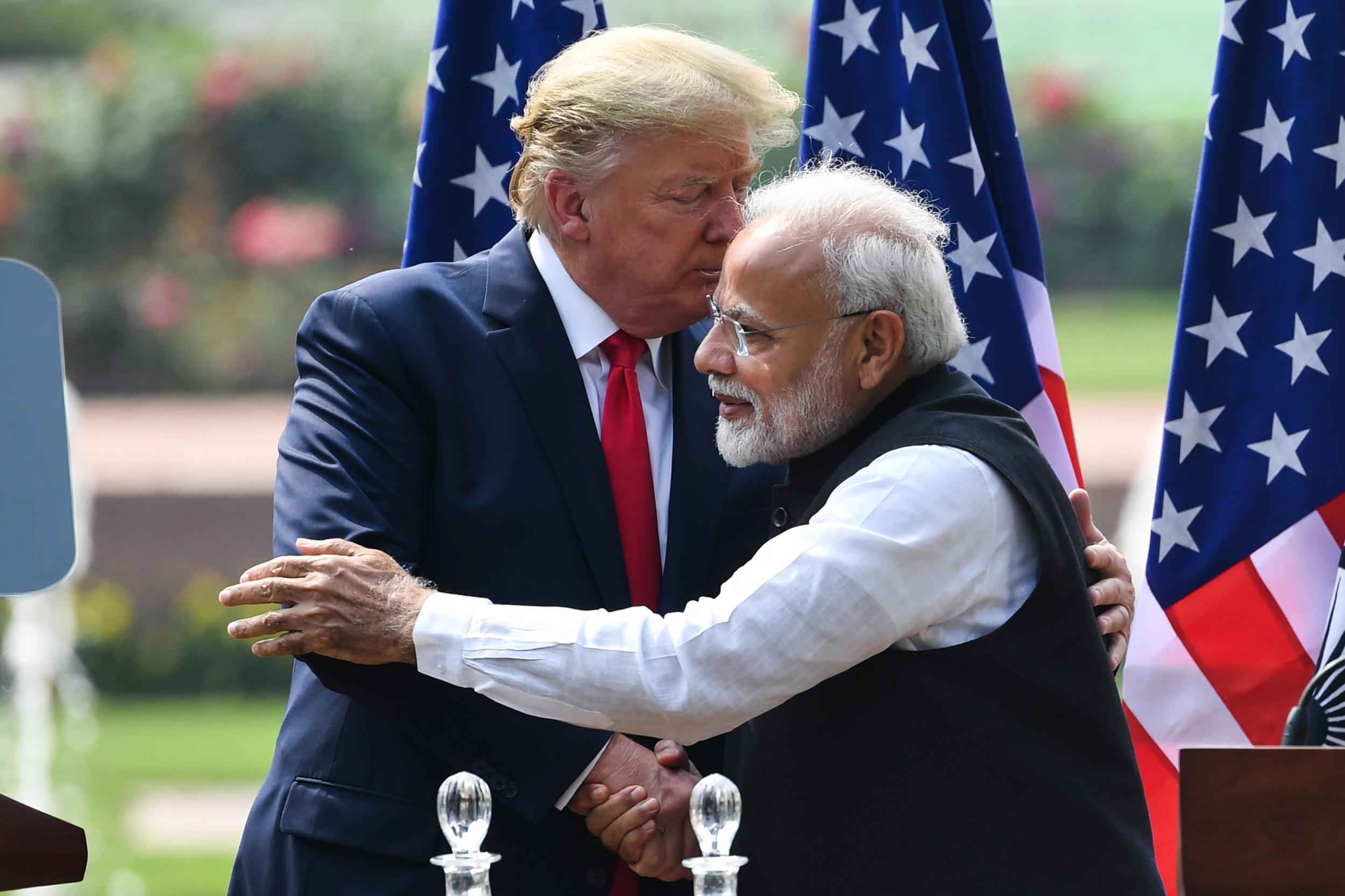The real reason behind Trump’s visit to India
As the 2020 election looms on the horizon, the US president is attempting to entice more than 4.5 million Indian-Americans scattered across the US, writes Andrew Buncombe


Everybody knows Donald Trump likes a spectacle, especially when it’s put on for his behalf.
From strolling with Emmanuel Macron on the Champs-Elysees, to stepping into North Korea with Kim Jong-un, and even tea with Queen Elizabeth at Buckingham Palace, foreign governments have realised making a fuss of the US president is likely the most effective form of diplomacy.
Where better then, for the president to visit than India, a fabulously friendly nation where people love celebrities, and which, with the use of huge crowds, marching bands on camels, and props such as the Taj Mahal, knows how to put on a show nobody forgets.
“America loves India. America respects India,” Trump told crowds in the western state of Gujarat earlier this week. “And America will always be faithful and loyal friends to the Indian people.”
During the trip and on his return to Washington, Trump talked up the prospect of major deals including the sale of $3bn (£2.4bn) worth of US military equipment including helicopters.
Yet there was another reason Trump was so keen to visit Ahmedabad, Agra and Delhi during a 36-hour rapid blitz tour – Indian-American voters in the US. In 2016, Trump managed to secure just 16 per cent of their support. In 2020, he would like to do much better.
“I think [outreach to Indian-Americans] has to be part of his calculation,” says Seema Sirohi, a DC-based columnist for India’s Economic Times and a veteran analyst of India-US relations.
“This came after the rally in Houston [in September] where he appeared alongside Narendra Modi, who is very popular. Trump has been very supportive of Modi. The hope is this results in votes in some of these difficult states.”
Estimates suggest there may be as many 4.5 million Indian-Americans, who have long been considered the nation’s wealthiest and most successful ethnic community. While there are large populations in places such as New York and New Jersey, there are also sizeable communities in Michigan, Pennsylvania, the city of Atlanta, and Texas. Florida is also home to many Indian-Americans.
While Trump’s support has remained solid in the low 40s, most commentators see little way for him to expand his base ahead of November. Yet given he secured the White House by just 77,000 votes scattered over the states of Michigan, Wisconsin and Pennsylvania, even improving on 2016’s 16 per cent by just a few points could prove crucial.
The president has similarly been trying to build support among African Americans and Latinos, blocs that have typically voted Democrat. Last week, as polls showed Trump’s support among Latinos had crept up two points to thirty points, senior Hispanic politicians warned the Democratic Party it needed to step up outreach and talk to Latinos about a variety of issues, not simply immigration.
In Modi, Trump has found an ally he can relate to. Both seek to project an image of strength and power. Both emphasise putting their own countries first, no matter the consequences.
And in Trump, Modi has found someone who won’t trouble him with issues such as human rights. The Indian prime minister, who was re-elected in a landslide last spring, rose to prominence and power amid accusations he had failed to prevent and even encouraged, the slaughter of hundreds of Muslims in his home state state of Gujarat. For more than a decade, he was boycotted by Washington and London.
Yet, as it emerged he was set to become prime minister in 2014, and under pressure from US and UK businesses, such prohibitions were quickly dropped. Trump’s visit to India came as its capital city was burning and at least 30 people were killed amid religious violence, triggered by Modi’s introduction of the so-called Citizenship Amendment Act which targeted Muslims.
Trump also did not mention, at least not in public, the clampdown in Kashmir, whose special status was revoked last year and its leaders detained.
After all, given one of the president’s landmark executive orders was a “Muslim ban” to block travel to the US from citizens from a group of predominantly Muslim nations, why would he care what abuses have been taking place on the streets of Guwahati or Srinagar?
But winning over Indian-Americans may not be as simple as Trump hopes.
“The White House believes that the image of Trump standing shoulder-to-shoulder with Modi, whose popularity among the diaspora remains high, will serve the Republican Party well in the 2020 election,” says Milan Vaishnav, fellow at the Carnegie Endowment for International Peace.
“Ultimately, I think this view is misguided as the fundamental obstacles to Indian-American support for the GOP remain: a tough stance on immigration laws and a proclivity to embrace right-wing, evangelical positions on social policy.”
This week, at a press conference about the coronavirus, Trump was asked about his visit to India and the time he spent with Modi.
“He is a great gentleman, a great leader. India is an incredible country,” said Trump.
“We were treated very, very well and we really enjoyed it. A lot of tremendous progress was made in terms of relationship – our relationship with India is extraordinary right now.”
Join our commenting forum
Join thought-provoking conversations, follow other Independent readers and see their replies
Comments